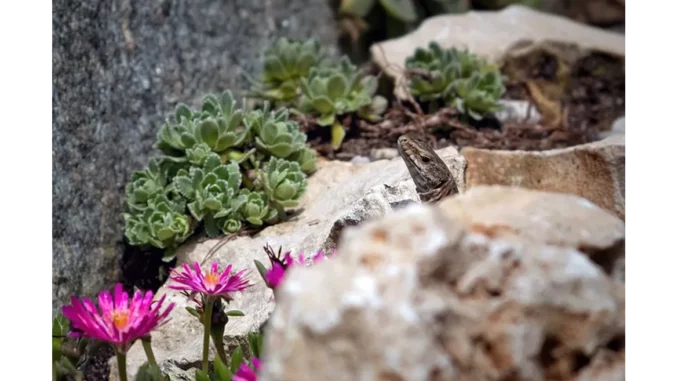
Rock gardens offer an innovative and stunning way to transform your outdoor space, combining natural elegance with practicality. They not only enhance the visual appeal of your landscape but also provide a sustainable solution to water shortages by featuring drought-tolerant plants. To delve deeper into this fascinating subject, I had the pleasure of speaking with Emily Thompson, a seasoned horticulturist and landscape designer, who shared her insights and experiences on selecting the right plants for rock gardens.
The Importance of Plant Selection
“Selecting suitable plants for rock gardens is crucial for successful gardening due to harsh conditions and limited soil,” Emily began. “Rock gardens mimic natural alpine environments where plants must endure extreme weather, poor soil, and limited water. Therefore, choosing the right plants is essential for creating a thriving and low-maintenance garden.”
Rock gardens often face harsh conditions, including intense sunlight, strong winds, and minimal soil depth. These factors necessitate the use of hardy, drought-resistant plants that can withstand the elements. Emily explained that succulents, alpines, and native species are excellent choices because they naturally thrive in such environments.
Drought-Resistant Heroes: Succulents
“Succulents are the kings of drought resistance,” Emily noted with enthusiasm. “Their ability to store water in their leaves makes them incredibly resilient and low-maintenance.”
Succulents like the Golden Barrel Cactus (Echinocactus grusonii) and Foxtail Agave (Agave attenuata) are prime examples. The Golden Barrel Cactus, with its distinctive round shape and vibrant golden colour, serves as a striking focal point in any rock garden. It thrives in rocky environments and requires minimal watering, making it an ideal choice for gardeners looking to reduce water usage.
The Foxtail Agave, on the other hand, adds a touch of drama and elegance with its long, slender leaves that resemble a fox’s tail. This plant not only survives but thrives in arid conditions, making it a perfect fit for rock gardens.
Native Plants: Nature’s Gift to Gardeners
“Native plants are another excellent choice for rock gardens,” Emily continued. “They are well-adapted to their local environments and often require less maintenance and water.”
Native plants like the Rock Cress (Arabis hybrida) and Blue Chalk Sticks (Senecio mandraliscae) are perfect examples. Rock Cress, with its delicate white, purple, or pink flowers, is a versatile ground cover that attracts butterflies and is resistant to deer and rabbits. Its ability to thrive in rocky, well-drained soil makes it a favourite among rock garden enthusiasts.
Blue Chalk Sticks, known for their striking blue-grey cylindrical leaves, create a stunning contrast against the earthy tones of rocks. Their trailing habit makes them perfect for cascading over the edges of rocks or walls, adding a touch of elegance to the garden.
Alpine Plants: Masters of Survival
“Alpine plants are specifically adapted to thrive in rocky, mountainous environments,” Emily explained. “They are hardy, resilient, and often require minimal care.”
Plants like the Purple Gem Rockcress (Aubrieta deltoide) and Creeping Thyme (Breckland Thyme) are excellent choices for rock gardens. Purple Gem Rockcress, with its vibrant purple flowers and mat-forming habit, adds a burst of colour and texture to any rock garden. It is a resilient plant that tolerates harsh conditions and requires minimal water.
Creeping Thyme, on the other hand, is a slow-growing ground cover with tiny vibrant blooms. Its aromatic and tasty herbs make it a great addition to any garden, and its ability to fill crevices and sprawl over rocks adds a touch of natural beauty to the landscape.
Designing Your Rock Garden
Emily emphasised the importance of thoughtful design when creating a rock garden. “Incorporating different sizes and shapes of plants and rocks can help create depth and visual appeal,” she advised. “Consider the growth patterns and light requirements of your plants, and arrange them accordingly to create a harmonious and attractive landscape.”
She also recommended using large and medium-sized boulders as focal points and incorporating different types of rocks to add texture and interest. “The mix of textures, colours, and forms will create a dynamic and eye-catching display that will surely impress anyone who sees it.”
Final Thoughts
Creating a rock garden involves more than just selecting the right plants. It requires careful planning, thoughtful design, and regular maintenance to ensure its long-lasting beauty. “Watering techniques, soil preparation, and occasional pruning are essential for maintaining a thriving rock garden,” Emily concluded. “But with the right plants and a little bit of care, you can create a stunning and sustainable outdoor space that will bring you joy for years to come.”
In summary, selecting suitable plants for rock gardens is a crucial step in ensuring successful gardening. By choosing drought-resistant plants like succulents, native species, and alpine plants, you can create a beautiful and low-maintenance landscape that thrives in harsh conditions. With careful planning and thoughtful design, your rock garden can become a stunning focal point that enhances the overall aesthetic of your outdoor space.
Tobiasz Karcz


Be the first to comment